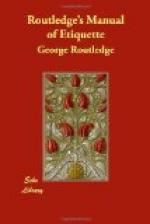Duties to be Attended to the Day before the Wedding.
The bride now sends white gloves, wrapped in white paper and tied with white ribbon, to each of the bridesmaids.
The bridegroom does the same to each of the bridegroomsmen.
One portion of the wedding cake is cut into small oblong pieces, and passed by the bridesmaids through the wedding ring, which is delivered into their charge for this purpose. The pieces of cake are afterwards put up in ornamental paper, generally pink or white, enamelled, and tied with bows of silvered paper. This pleasant old custom is, however, much on the wane.
The bridegroom’s “best man” on this day must take care that due notice be sent to the clerk of the parish where the ceremony is to take place, so that the church may be got ready, and the clergyman be in attendance.
It is usual too for the bridegroom’s “best man” to make arrangements for the church bells being rung after the ceremony: the rationale of this being to imply that it is the province of the husband to call on all the neighbours to rejoice with him on his receiving his wife, and not that of the lady’s father on her going from his house.
The bridegroom furnishes to the bridesmaids his list for the “Cards” to be sent to his friends; of which hereafter.
On the evening of this day the wedding breakfast should be ornamented and spread out, as far as possible, in the apartment appropriated to it.
The bridesmaids on this evening also prepare the wedding favours, which should be put up in a box ready to be conveyed to the church on the morning of the marriage. A picturesque custom is observed in many country weddings, where the bride’s friends strew her path to the church door with flowers.
* * * * *
V.—ETIQUETTE OF A WEDDING.
The parties being assembled on the wedding morning in the drawing-room of the residence of the bride’s father (unless, as sometimes happens, the breakfast is spread in that room), the happy cortege should proceed to the church in the following order:—
In the first carriage, the bride’s mother and the parents of the bridegroom.
In the second and third carriages, bridesmaids.
Other carriages with the bride’s friends.
In the last carriage, the bride and her father.
Costume of the Bride.
A bride’s costume should be white, or some hue as close as possible to it. Fawn colour, grey, and lavender are entirely out of fashion. It is considered more stylish for a very young bride to go without a bonnet, but for her head to be covered with only a wreath of orange blossoms and a Chantilly or some other lace veil. This, however, is entirely a matter of taste; but, whether wearing a bonnet or not, the bride must always wear a veil. If a widow, she may wear not only a bonnet, but a coloured silk dress.




